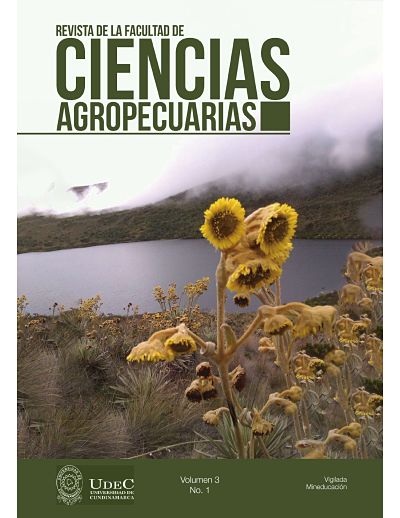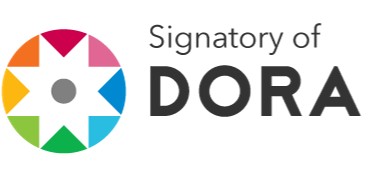Diagnosis of diseases in the spray rose (Rosa spp) crop of the Tucán Flowers S.A. marketing company in the municipality of Cogua, Cundinamarca
DOI:
https://doi.org/10.36436/24223484.219Keywords:
Mildeo polvoso, mildeo velloso, deficiencias nutricionales.Abstract
Rose cultivation is important to the Colombian economy as a source of income. However, it is affected by several pathogens, which generate low production yields due to poor flower quality. The main diseases include powdery mildew and downy mildew. To characterize the causative agents of these diseases, a sampling was conducted at the Tucán Flowers marketing company in Cogua, Cundinamarca. This company produces and exports spray roses. The incidence and severity of the diseases and nutritional deficiencies found were evaluated. A total of 540 plants were sampled, corresponding to 0.25% of the three randomly selected significant areas of the crop. The signs and symptoms of each abnormality were observed and recorded. Plant material was then collected to diagnose the causative agent of the diseases using a humidity chamber and direct imprinting. Nutritional deficiencies were determined from literature. The results show a high incidence of powdery mildew at 39.44%, followed by downy mildew at 27.96%; however, the severity percentage is not significant. The causative agents of powdery mildew were identified as Oidium sp. and downy mildew as Peronospora sp. Nutritional deficiencies of potassium, iron, and boron, among others, were also observed.Downloads
References
Reyes F, Duque J, Cáceres N, Valero E. 2016. Superintendencia de sociedades: Desempeño del sector floricultor. Informe. Bogotá D.C. Recuperado de http://www.supersociedades.gov.co/noticias/
Documents/2016/EE-Estudio%20sector%20Flores-2016%20VI%2013_Final.pdf
Vargas C. 2016 Controles exitosos de mildeo polvoso (Sphaerotheca pannosa) en rosa (rosa sp) de la sabana de Bogotá empleando subticrop (Bacillus subtilis). Metroflor Ed. 56. Recuperado de http://www.metroflorcolombia.com/rev/REVISTA%20COMPLETA%20PARA%20WEB.pdf
Cardozo O. 2016 Alternativa arista lifescience para el control de mildeo polvoso (Sphaerotheca pannosa) en el cultivo de rosas. Metroflor. Ed. 56. Recuperado de http://www.metroflorcolombia.com/rev/REVISTA%20COMPLETA%20PARA%20WEB.pdf
Perilla L. & Sanabria A. 2007. Condiciones que favorecen el desarrollo del mildeo polvoso en los cultivos de rosa en la sabana de Bogotá [Tesis de grado]. Bogotá: Colombia. Pontificia Universidad Javeriana. Facultad de ciencias básicas, 2007. Recuperado de http://javeriana.edu.co/biblos/tesis/ciencias/tesis36.pdf
Ayala-Vásquez M, Argel-Roldan L, Marín-Montoya M. 2007. Diversidad genética de Peronospora sparsa(Peronosporaceae) en cultivos de rosas en Colombia. Acta biol. Colomb., 2008. 13 (1): 79-94.
Domínguez-Serrano D., García-Velasco R., MoraHerrera M E., Salgado-Siclan M & González-Díaz J G. 2016 La cenicilla del rosal (Podosphaera pannosa). Agrociencia. 50 (7): 901-917.
López J. 1981. Cultivo del rosal en invernadero. (España) Ediciones Mundi-Prensa.
Álvarez P, García R, Mora M, González J, Salgado M. 2013 Estado actual de Peronospora sparsa, causante del Mildiu Velloso en Rosa (Rosa sp.). Rev. mex. Fitopatol.31(2) 113-125.
FAO. 1999. Guía para el manejo eficiente de la nutrición de las plantas. Roma, Italia. Recuperado de ftp://ftp.fao.org/agl/agll/docs/gepnms.pdf
Calderón F. Por qué se presentan clorosis en la hojas de las Rosas?. Calderón laboratorios Ltda. Colombia: Bogotá 1998. Recuperado de http://www.drcalderonlabs.com/Labnews/Labnews7.html
Downloads
Published
How to Cite
Issue
Section
License
Copyright (c) 2020 Ciencias agropecuarias

This work is licensed under a Creative Commons Attribution-NonCommercial-NoDerivatives 4.0 International License.







